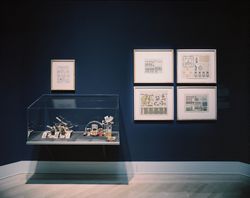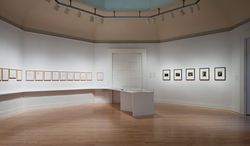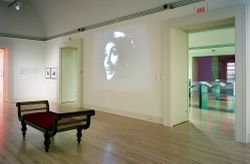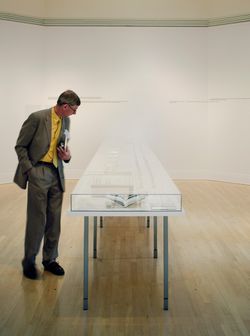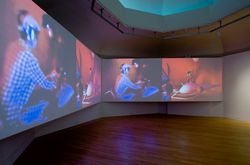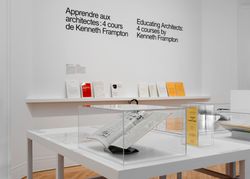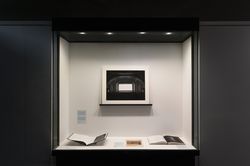events
Speed and its Limits
Speed and its Limits explores the pivotal role played by speed in modern life: from art to architecture and urbanism to graphics and design to economics to the material culture of the eras of industry and information. A colloquium organised by the CCA, in collaboration with the Wolfsonian-Florida International University and Stanford Humanities Lab, in preparation for the(...)
Paul Desmarais Theatre
21 June 2008, 9am - 5pm
Speed and its Limits
Actions:
Description:
Speed and its Limits explores the pivotal role played by speed in modern life: from art to architecture and urbanism to graphics and design to economics to the material culture of the eras of industry and information. A colloquium organised by the CCA, in collaboration with the Wolfsonian-Florida International University and Stanford Humanities Lab, in preparation for the(...)
events
21 June 2008
9am - 5pm
Paul Desmarais Theatre
The Anatomy of the Architectural Book, an exhibition presented in conjunction with the publication of a book of the same title by André Tavares, examines the relationships between book culture and building culture, making visible the axes along which architectural knowledge circulates through books into buildings and back. Through seven themes—Texture, Spread, Sequence,(...)
10 May 2016 to 20 November 2016
The Anatomy of the Architectural Book
Actions:
Description:
The Anatomy of the Architectural Book, an exhibition presented in conjunction with the publication of a book of the same title by André Tavares, examines the relationships between book culture and building culture, making visible the axes along which architectural knowledge circulates through books into buildings and back. Through seven themes—Texture, Spread, Sequence,(...)
Architecture, though constrained by boundaries of function and structure, is always ultimately an act of the imagination. Potential Architecture: Construction Toys from the CCA Collection explores twenty-one construction toys, made in the hundred years from 1850 to 1950, that were designed to challenge a child’s creativity. The toys illustrate how children learn to invent(...)
Octagonal gallery
4 December 1991 to 8 March 1992
Potential Architecture: Construction Toys from the CCA Collection
Actions:
Description:
Architecture, though constrained by boundaries of function and structure, is always ultimately an act of the imagination. Potential Architecture: Construction Toys from the CCA Collection explores twenty-one construction toys, made in the hundred years from 1850 to 1950, that were designed to challenge a child’s creativity. The toys illustrate how children learn to invent(...)
Octagonal gallery
Portuguese architect Álvaro Siza travelled to Peru in 1995 with his usual baggage: only a few changes of clothes, some books of poetry, and a single sketchbook. This was the toolkit he used to interpret the voyage and integrate it into his architecture. More than half a century earlier, Peruvian photographer Martín Chambi had taken his famous series of portraits of the(...)
Octagonal gallery
26 January 2012 to 29 April 2012
Alturas de Machu Picchu: Martín Chambi – Álvaro Siza at work
Actions:
Description:
Portuguese architect Álvaro Siza travelled to Peru in 1995 with his usual baggage: only a few changes of clothes, some books of poetry, and a single sketchbook. This was the toolkit he used to interpret the voyage and integrate it into his architecture. More than half a century earlier, Peruvian photographer Martín Chambi had taken his famous series of portraits of the(...)
Octagonal gallery
Absent Wall: Recalling Gordon Matta-Clark’s Garbage Wall (1970), an installation in the CCA’s Baile Park, is a symbolic structure that evokes Matta-Clark’s interest in recycling, leftover spaces, and alternatives to architectural design. On the occasion of the first Earth Day, Gordon Matta-Clark orchestrated an event at Manhattan’s St. Mark’s Church that took place from(...)
Baile Park
6 May 2004 to 6 September 2004
Absent Wall: Recalling Gordon Matta-Clark’s Garbage Wall (1970)
Actions:
Description:
Absent Wall: Recalling Gordon Matta-Clark’s Garbage Wall (1970), an installation in the CCA’s Baile Park, is a symbolic structure that evokes Matta-Clark’s interest in recycling, leftover spaces, and alternatives to architectural design. On the occasion of the first Earth Day, Gordon Matta-Clark orchestrated an event at Manhattan’s St. Mark’s Church that took place from(...)
Baile Park
Traces of India depicts the social, political, and anthropological role of images, showing how they laid the historical foundations—real and imagined—on which an ordered empire may have been constructed, rather than an assemblage of colonial trading relationships. Organized around six themes, the exhibition explores some of the greatest architectural sites of the Indian(...)
Main galleries
15 May 2003 to 14 September 2003
Traces of India: Photography, Architecture, and the Politics of Representation
Actions:
Description:
Traces of India depicts the social, political, and anthropological role of images, showing how they laid the historical foundations—real and imagined—on which an ordered empire may have been constructed, rather than an assemblage of colonial trading relationships. Organized around six themes, the exhibition explores some of the greatest architectural sites of the Indian(...)
Main galleries
Learning from… Ruscha and Venturi Scott Brown, 1962–1977 examines the relationship between the seminal illustrated books by artist Edward Ruscha and architects Robert Venturi and Denise Scott Brown that deal with the architecture and urbanism of the everyday in Los Angeles and Las Vegas during the 1960s and 1970s. Ruscha’s Every Building on the Sunset Strip and Venturi(...)
Octagonal gallery
31 March 2004 to 30 May 2004
Learning from… Ruscha and Venturi Scott Brown, 1962–1977
Actions:
Description:
Learning from… Ruscha and Venturi Scott Brown, 1962–1977 examines the relationship between the seminal illustrated books by artist Edward Ruscha and architects Robert Venturi and Denise Scott Brown that deal with the architecture and urbanism of the everyday in Los Angeles and Las Vegas during the 1960s and 1970s. Ruscha’s Every Building on the Sunset Strip and Venturi(...)
Octagonal gallery
“Today everything is environment,” proclaimed a Montreal newspaper at the beginning of the 1970s. The word “environment” had dominated the discourses and practices of artists, architects, social activists and intellectuals during the previous decade. Visitors of Expo ‘67, the event that galvanized the world’s attention on Montreal, commented the phantasmagorical(...)
Octagonal gallery
19 March 2009 to 23 August 2009
Total Environment: Montréal, 1965-1975
Actions:
Description:
“Today everything is environment,” proclaimed a Montreal newspaper at the beginning of the 1970s. The word “environment” had dominated the discourses and practices of artists, architects, social activists and intellectuals during the previous decade. Visitors of Expo ‘67, the event that galvanized the world’s attention on Montreal, commented the phantasmagorical(...)
Octagonal gallery
Amid education reform in American schools of architecture in the 1970s, Kenneth Frampton was integral in transforming the curriculum of Columbia University’s Graduate School of Architecture Planning. In particular, he designed and taught what became three core courses: the theory seminar “Comparative Critical Analysis,” the history lectures “Thresholds of Modern(...)
31 May 2017 to 24 September 2017
Educating Architects: Four Courses by Kenneth Frampton
Actions:
Description:
Amid education reform in American schools of architecture in the 1970s, Kenneth Frampton was integral in transforming the curriculum of Columbia University’s Graduate School of Architecture Planning. In particular, he designed and taught what became three core courses: the theory seminar “Comparative Critical Analysis,” the history lectures “Thresholds of Modern(...)
Mirrors / Miroirs
Mirrors/ Miroirs is conceived through an indirect dialogue with the exhibition Besides, History: Go Hasegawa, Kersten Geers, David Van Severen, a project rooted in the shared references and resonances between the work of two contemporary practices in the presence of history. If Besides, History is premised on impressions of one office’s work registered through(...)
Hall cases
22 June 2017 to 14 January 2018
Mirrors / Miroirs
Actions:
Description:
Mirrors/ Miroirs is conceived through an indirect dialogue with the exhibition Besides, History: Go Hasegawa, Kersten Geers, David Van Severen, a project rooted in the shared references and resonances between the work of two contemporary practices in the presence of history. If Besides, History is premised on impressions of one office’s work registered through(...)
Hall cases

